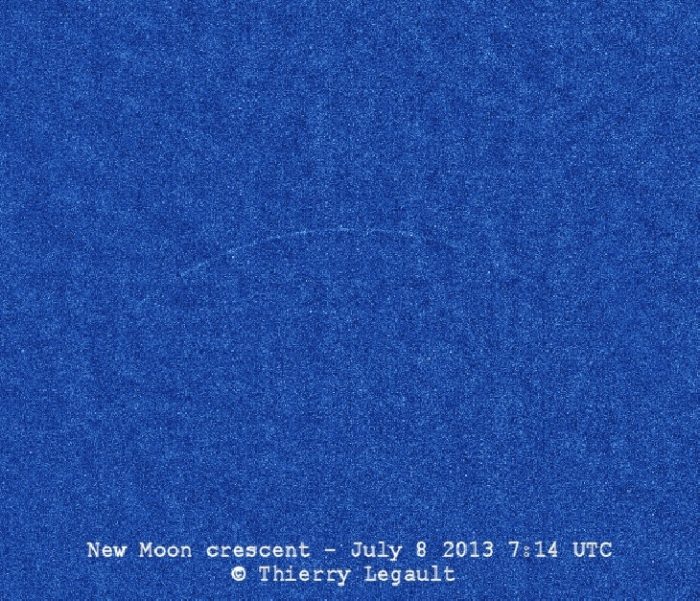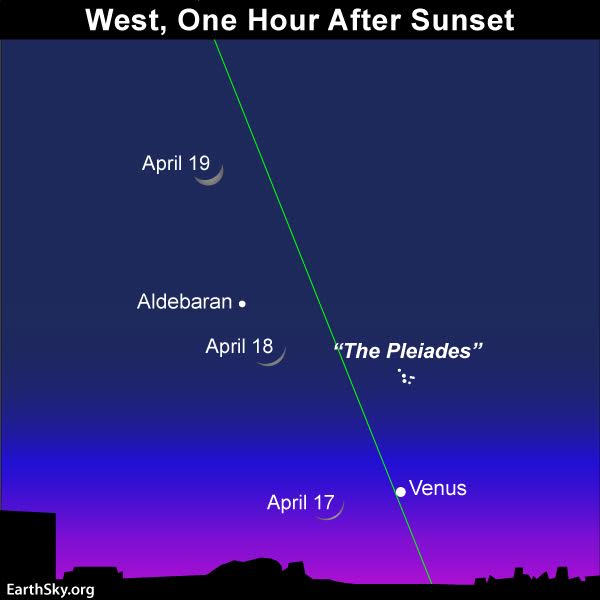

Youngest possible lunar crescent, with the moon’s age being exactly zero when this photo was taken — at the instant of new moon – 07:14 UTC on July 8, 2013. Image by Thierry Legault.
A moon at the new phase comes most nearly – for any particular month – to passing between the Earth and sun. New moon is April 16 at 1:57 UTC. At North American time zones, that means the new moon happened on April 15, at 10:57 p.m. ADT, 9:57 p.m. EDT, 8:57 p.m. CDT, 7:57 p.m. MDT, 6:57 p.m. PDT, 5:57 p.m. Alaskan Time and 3:57 p.m. Hawaiian Time. Translate UTC to your time.
New moons come once each month, as the moon orbits Earth. On the day of new moon – unless we’re viewing a total solar eclipse – we don’t see the new moon. That’s because a new moon rises when the sun rises. It sets when the sun sets. It crosses the sky with the sun during the day. Its fully illuminated face, or day side, is turned entirely away from us.
It’s only as the moon moves in orbit, as its lighted hemisphere begins to come into view from Earth, that we can see it in our sky. Then we see the moon in the west after sunset as a slim waxing crescent – what some call a young moon.
This month’s young moon might be visible in the west for some in North America, and on Pacific islands, on the evening of new moon itself, April 16. See the chart below:

This chart is for April 16, 2018 shortly after sunset. You probably have to be in North America, or on a Pacific Island in the Northern Hemisphere, to glimpse the young moon that evening. The brilliant starlike object in the evening sky at that time of night is Venus!
If you’re in Asia on April 16 – in the Southern Hemisphere (where it’s autumn now, the worst time to catch a very young moon) – you might have to wait until April 17 to see the young moon. On that evening, there will be a wonderful display of the young moon next to the brilliant planet Venus. The moon will be climbing higher in the west after sunset day by day, as shown on the next chart:

The moon will be climbing upward and staying out later in the days ahead. Although we show the Pleiades cluster on the chart, you may well need binoculars to see this cluster in the haze of evening twilight.
As the moon orbits Earth, it changes phase in an orderly way. Follow these links to understand the various phases of the moon.
Four keys to understanding moon phases
Where’s the moon? Waxing crescent
Where’s the moon? First quarter
Where’s the moon? Waxing gibbous
What’s special about a full moon?
Where’s the moon? Waning gibbous
Where’s the moon? Last quarter
Where’s the moon? Waning crescent
Where’s the moon? New phase
from EarthSky https://ift.tt/19T9DUm


Youngest possible lunar crescent, with the moon’s age being exactly zero when this photo was taken — at the instant of new moon – 07:14 UTC on July 8, 2013. Image by Thierry Legault.
A moon at the new phase comes most nearly – for any particular month – to passing between the Earth and sun. New moon is April 16 at 1:57 UTC. At North American time zones, that means the new moon happened on April 15, at 10:57 p.m. ADT, 9:57 p.m. EDT, 8:57 p.m. CDT, 7:57 p.m. MDT, 6:57 p.m. PDT, 5:57 p.m. Alaskan Time and 3:57 p.m. Hawaiian Time. Translate UTC to your time.
New moons come once each month, as the moon orbits Earth. On the day of new moon – unless we’re viewing a total solar eclipse – we don’t see the new moon. That’s because a new moon rises when the sun rises. It sets when the sun sets. It crosses the sky with the sun during the day. Its fully illuminated face, or day side, is turned entirely away from us.
It’s only as the moon moves in orbit, as its lighted hemisphere begins to come into view from Earth, that we can see it in our sky. Then we see the moon in the west after sunset as a slim waxing crescent – what some call a young moon.
This month’s young moon might be visible in the west for some in North America, and on Pacific islands, on the evening of new moon itself, April 16. See the chart below:

This chart is for April 16, 2018 shortly after sunset. You probably have to be in North America, or on a Pacific Island in the Northern Hemisphere, to glimpse the young moon that evening. The brilliant starlike object in the evening sky at that time of night is Venus!
If you’re in Asia on April 16 – in the Southern Hemisphere (where it’s autumn now, the worst time to catch a very young moon) – you might have to wait until April 17 to see the young moon. On that evening, there will be a wonderful display of the young moon next to the brilliant planet Venus. The moon will be climbing higher in the west after sunset day by day, as shown on the next chart:

The moon will be climbing upward and staying out later in the days ahead. Although we show the Pleiades cluster on the chart, you may well need binoculars to see this cluster in the haze of evening twilight.
As the moon orbits Earth, it changes phase in an orderly way. Follow these links to understand the various phases of the moon.
Four keys to understanding moon phases
Where’s the moon? Waxing crescent
Where’s the moon? First quarter
Where’s the moon? Waxing gibbous
What’s special about a full moon?
Where’s the moon? Waning gibbous
Where’s the moon? Last quarter
Where’s the moon? Waning crescent
Where’s the moon? New phase
from EarthSky https://ift.tt/19T9DUm

Aucun commentaire:
Enregistrer un commentaire